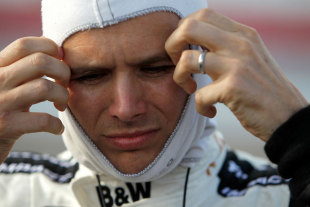- IndyCar news
IndyCar publishes report into Wheldon's death

A report into the Dan Wheldon's death at the Las Vegas 300 last October has confirmed he was killed by a head injury after contact with catch fencing.
Wheldon died following a 15-car pile-up in which his car was launched into the air before landing in the catch fencing. On Thursday the series published a 60-page report into the incident with the initial results indicating that contact with catch fencing resulted in Wheldon's fatal head injury.
"The chassis of the #77 [Dan Wheldon's car] impacted a post along the right side of the tub, created a deep defect in the tub that extended from the pedal bulkhead along the upper border of the tub through the cockpit," a section of the report read "This resulted in angular deformation of the roll hoop that was sheared off the tub from right to left. As the race car passed by, the pole intruded into the cockpit and made contact with the driver's helmeted head. This was evidenced by damage to the right side of the helmet at the lower interface surface of the helmet and visor. The impact damaged the structure of the face portion, or chin bar, of the helmet and dislodged the visor from its anchor point on the right temple. It resulted in fracturing of the helmet on the face portion as well as damage to the attachment points of the visor on the right side. This impact produced non-survivable blunt force trauma injuries to Dan's head. Dan's injury was limited to this head injury."
The report added: "Dan appeared to suffer two distinct head forces during the accident. The first significant force for Dan's head took place approximately 1.7 seconds after the impact with the #83 race car [Charlie Kimball]. There is no video that correlated to Dan's head actually hitting anything in the first force. This force to the chassis of -30Gs lateral, 47Gs longitudinal, and -25Gs vertical is likely the result of the reaction of the right rear of the #77 [Dan Wheldon] experiencing contact with the racing surface and #59 [Ernesto Viso]. This is typical in other accidents where no other race cars or debris are present. In this first force, the head experienced forces of approximately 50Gs rearward, 100Gs lateral, as well as 100Gs vertical. Using this information, a Head Injury Criteria (HIC) number was calculated and was well below 1000. A HIC number below 1000 indicated it is a level low enough that normally does not produce any injury.
"The second head force was a physical impact, and took place 0.4 seconds after the first force, and 2.1 seconds after #77 made contact with #83. There was good video correlation to the steering bulkhead, helmet, and roll bar hitting the pole supporting the catch fence on this time line. This correlation was achieved by setting a datum on the video at the point where the #77 and the #83 race cars made contact. Then, having used the time in the crash box data, each of the impacts were identified on the video. Prior to the driver's earplug sensors becoming unplugged in the second impact, his head experienced longitudinal forces of approximately -250Gs which indicated a frontal impact, and -200Gs vertical which indicated a hit from the bottom, and 100Gs lateral to the right. The negative longitudinal spikes indicated frontal hits to the head. The polarities of the longitudinal and vertical forces indicated a frontal hit from the bottom toward the top. The earplug sensors appeared to come unplugged during the second head hit. This has been seen in other accidents when the driver moved far enough that the mating connector located at the rear of the tub reached the limit of its length."
The report also looked into criticisms over the number of cars in the race, the suitability of the track and the decision to start Wheldon from the back of the grid as part of a promotion. The conclusion of the report said that no single reason could be blamed for the sport and that the promotion had absolutely no bearing on the incident.
"The accident was significant due to the number of race cars damaged, but more importantly due to the non-survivable injuries to Dan Wheldon," it read. "While several factors coincided to produce a "perfect storm," none of them can be singled out as the sole cause of the accident. For this reason, it is impossible to determine with certainty that the result would have been any different if one or more of the factors did not exist.
"INDYCAR is committed to safety. This report is an interim step to INDYCAR's on-going efforts to improve motorsports safety. INDYCAR will continue its efforts to reduce the risks of racing to all.
"The 2012 racing season ushers in an era of a new IndyCar Series race car and the opportunity for unprecedented safety advancements. Dan Wheldon was instrumental in the testing and development of this new car and the safety innovations that it represents.
"The thoughts, prayers and deepest condolences of INDYCAR and the open wheel racing community go out to Dan's family."
Click here to read the full report.

